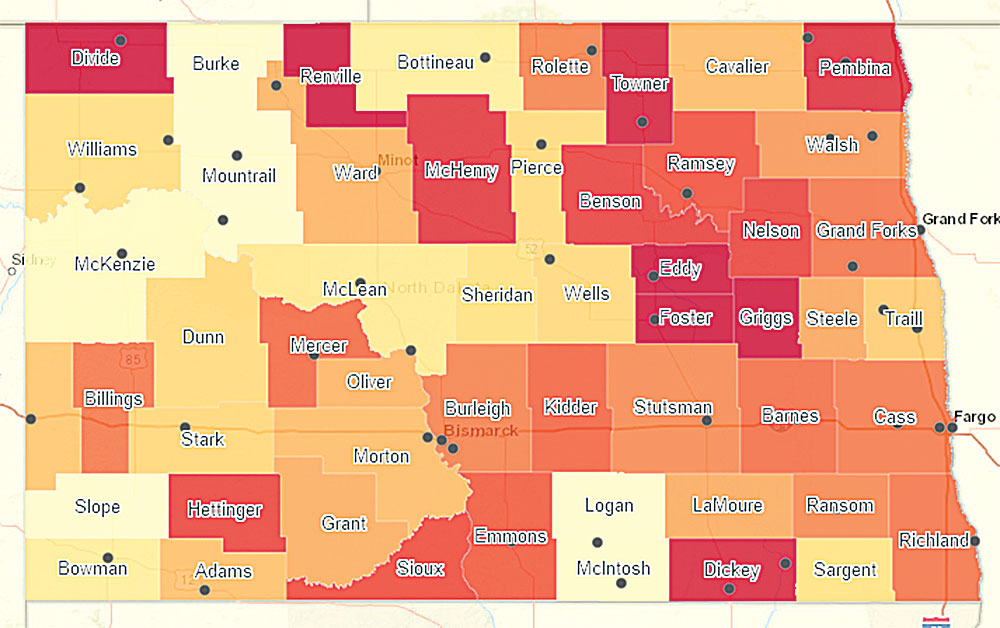ND economy continues uptick in 2019

Source: N.D. Tax Commission Lighter colors show greater growth and dark colors show decrease in taxable sales and purchases in the first quarter of 2019.
BISMARCK – Taxable sales and purchases were up just over 6% in both Minot and Ward County during the first quarter of 2019, according to the North Dakota Tax Commission.
Taxable sales of $233 million in Ward County compare to $219.5 million for the same quarter in 2018.
“I think there’s renewed optimism about what’s going on in our economy. I do think you are going to see more dollars being spent,” said John MacMartin, Minot Area Chamber of Commerce president. “I think things are set in place for a fairly decent year.”
Statewide taxable sales and purchases for January, February and March of 2019 were $4.453 billion, a 9.67% increase over those months in 2018
“We are pleased to report good year-over-year increases for the past eight quarters, five of which have seen nearly 10% growth or more,” Tax Commissioner Ryan Rauschenberger said in a news release. “It was no surprise to see a significant increase in this report with oil production hitting an all-time record of 1.4 million barrels per day in January.”
Some of the biggest changes were in and around oil country. Burke County was up 79.9%, from $4.35 million to $7.4 million. Mountrail County saw a 41% increase, from $44 million to $62 million. McKenzie County was up 24.3 %, from $57.7 million to $71.76 million. Williams County was up 14.9%, from $388 million to $388.5 million.
The greatest increase, though, was in Logan County in southcentral North Dakota, where overall sales tend to be small and certain purchases can have a big impact. The county saw a 96.48% increase to $3 million.
Thirteen of the 15 major sectors reported taxable sales and purchases gains when compared to the first quarter a year ago, according to the Tax Commission. The mining and oil extraction sector increased by $123.8 million or 21.65%.
MacMartin said efficiency gains in the oil industry have meant fewer oil-patch workers, but merchants also are settling into the new normal. Minot’s population has stabilized and may even be bouncing back a bit, he said. Oil service companies appear to be doing well, and that’s an aspect of the oil industry that continues to be key to Minot’s economy, he said.
Meanwhile, the Canadian monetary exchange rate, although not necessarily favorable, has been stable, which encourages neighbors to the north to once again consider coming south, MacMartin said. Business closures that have occurred, typically affecting national chains, have been for factors not associated with North Dakota’s economy, he said.
“The retail trade sector showed an increase of 5.39% when compared to last year,” Rauschenberger stated in the release. “This continues a recent trend of growth in this important sector. This is great news after several years of declines in this vital component of the state’s economy.”
Prior to the three most recent quarters, the state experienced at least 10 quarters of declines in the retail trade sector.
The Tax Commission reported three of the state’s top six largest cities saw an increase in taxable sales and purchases for the first quarter, all of which are on the west side of the state. Changes were: Williston, up 14.79%; Dickinson, up 11.69%; Minot, up 6.1%; Bismarck, down .48%; Fargo, down .61%; and Grand Forks, down 1.86%.
Of the 50 largest cities in North Dakota, the highest percent increases for the first quarter of 2019, compared to the first quarter of 2018, were: Garrison, 39.96%; Stanley, 35.24%; Wishek, 32.55%; Watford City, 24.91%; and Grafton, 21.40%.
Counties with the highest percent increases were: Logan, 96.48%; Burke, 70.9%; Mountrail, 41%; Slope, 29.41; and McIntosh, 25.58%.

